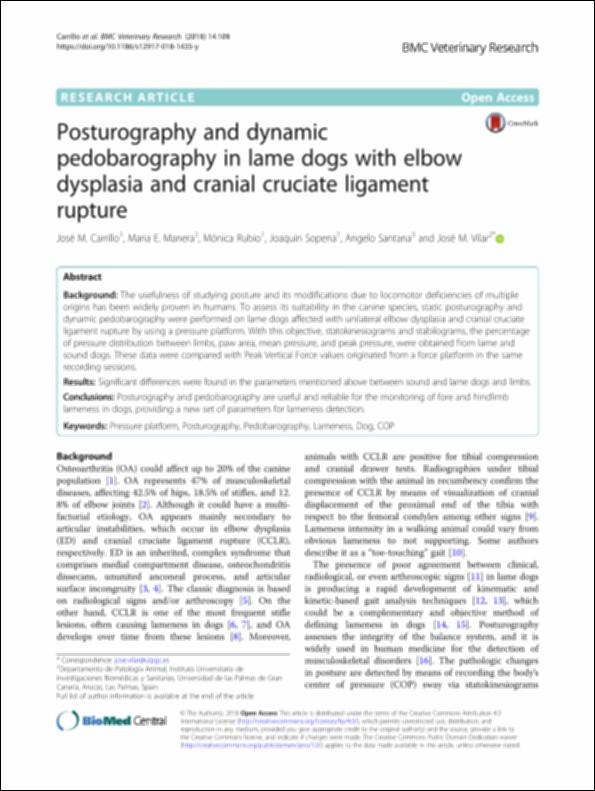Please use this identifier to cite or link to this item:
http://hdl.handle.net/10637/9985Posturography and dynamic pedobarography in lame dogs with elbow dysplasia and cranial cruciate ligament rupture
| Title: | Posturography and dynamic pedobarography in lame dogs with elbow dysplasia and cranial cruciate ligament rupture |
| Authors : | Carrillo Poveda, José María. Manera, María E. Rubio Zaragoza, Mónica. Sopena Juncosa, Joaquín Jesús. Santana, Angelo Vilar, José M. |
| Keywords: | Perros - Locomoción.; Dogs - Locomotion.; Lameness in dogs - Diagnosis.; Diagnóstico veterinario.; Animal mechanics.; Mecánica animal.; Cojera en los perros - Diagnóstico.; Miembros anteriores - Heridas y lesiones - Diagnóstico.; Animal locomotion.; Locomoción animal.; Miembros posteriores - Heridas y lesiones - Diagnóstico.; Arm - Wounds and injuries - Diagnosis.; Leg - Wounds and injuries - Diagnosis.; Veterinary medicine - Diagnosis. |
| Publisher: | BioMed Central. |
| Citation: | Carrillo, JM., Manera, ME., Rubio, M., Sopena, J., Santana, A. and Vilar, JM. (2018). Posturography and dynamic pedobarography in lame dogs with elbow dysplasia and cranial cruciate ligament rupture. BMC Veterinary Research, vol. 14, art. 108. DOI: https://doi.org/10.1186/s12917-018-1435-y |
| Abstract: | Background: The usefulness of studying posture and its modifications due to locomotor deficiencies of multiple origins has been widely proven in humans. To assess its suitability in the canine species, static posturography and dynamic pedobarography were performed on lame dogs affected with unilateral elbow dysplasia and cranial cruciate ligament rupture by using a pressure platform. With this objective, statokinesiograms and stabilograms, the percentage of pressure distribution between limbs, paw area, mean pressure, and peak pressure, were obtained from lame and sound dogs. These data were compared with Peak Vertical Force values originated from a force platform in the same recording sessions. Results: Significant differences were found in the parameters mentioned above between sound and lame dogs and limbs. Conclusions: Posturography and pedobarography are useful and reliable for the monitoring of fore and hindlimb lameness in dogs, providing a new set of parameters for lameness detection. |
| Description: | Este artículo se encuentra disponible en la página web de la revista en la siguiente URL: https://bmcvetres.biomedcentral.com/articles/10.1186/s12917-018-1435-y |
| URI: | http://hdl.handle.net/10637/9985 |
| Rights : | http://creativecommons.org/licenses/by/4.0/deed.es |
| ISSN: | 1746-6148. |
| Issue Date: | 24-Mar-2018 |
| Center : | Universidad Cardenal Herrera-CEU |
| Appears in Collections: | Dpto. Medicina y Cirugía Animal |
Items in DSpace are protected by copyright, with all rights reserved, unless otherwise indicated.


